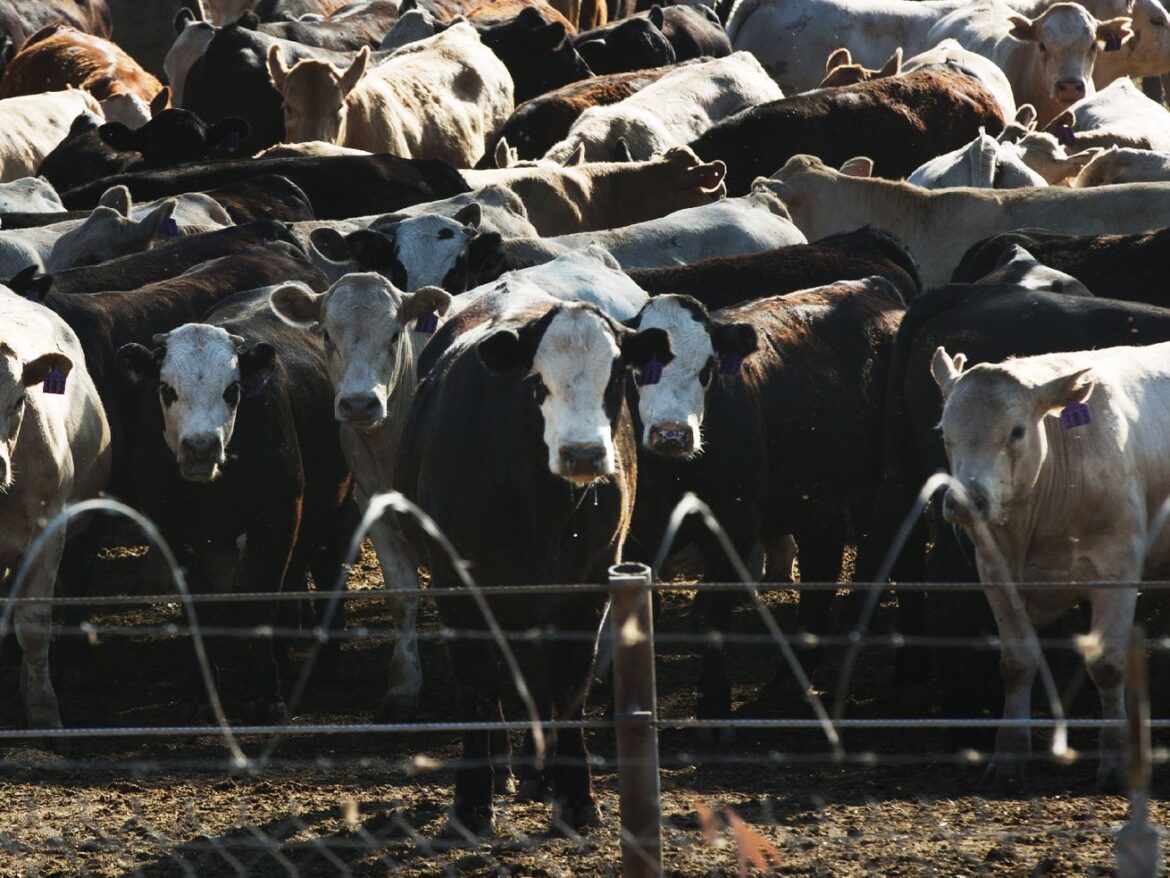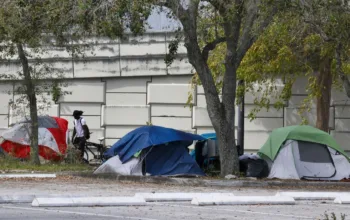As America gets ready to grill on Memorial Day, a reminder of meat’s role in climate change.
In 2006, the UN’s Food and Agriculture Organization (FAO) released a bombshell report, called “Livestock’s Long Shadow,” that focused public consciousness onto animal agriculture’s role in climate change. It turned out it wasn’t just cars, planes, and coal plants that belched planet-warming greenhouse gases into the atmosphere — it was also something as seemingly natural as the food we eat. The FAO estimated then that the production of meat, dairy, and eggs made up 18 percent of greenhouse emissions globally, a figure so high that, for many people in countries with high levels of meat consumption, dietary change came to be seen as perhaps the single most important step individuals could take to reduce their climate impact.
Since then, the FAO estimates have gone through a few more iterations. Last October, it released its most recent estimate of animal agriculture’s carbon footprint, using data from 2015 (each estimate uses data from several years prior). It put livestock’s share of total annual greenhouse gas emissions at about 11 percent — down from its previous estimate of 14.5 percent released in 2013, which itself was down from the 2006 estimate of 18 percent. In raw numbers, too, the new estimate is lower, with animal agriculture accounting for 6.19 billion tons of carbon dioxide-equivalent emissions compared to 7.1 billion tons the FAO reported in 2013.
This is a particularly surprising finding, given the rapidly growing number of animals raised for food globally. About 83 billion land animals were slaughtered for food in 2021 (chickens are the vast majority), up from about 68 billion a decade ago and 55 billion in 2006, according to FAO data. In the US, this Memorial Day weekend will kick off a summer grilling season when Americans alone are projected to consume some 7 billion hot dogs, or roughly 818 per second.
Compared to many peer-reviewed studies, which put livestock emissions at between 14.5 percent and 19.6 percent of the world’s total, the FAO’s new estimate (which is not peer-reviewed) is the lowest to date, according to an analysis by the Breakthrough Institute.
That raises an obvious question: why is it lower? There’s considerable uncertainty on the answer among scientists. Peer-reviewed research continues to warn that emissions from agriculture, most of which are driven by animal agriculture, could push global temperature rise past the Paris Agreement limit of 1.5°C.
“It is hard to say why the new FAO number is lower based on their documentation,” said Joseph Poore, a specialist in food sustainability analytics at Oxford University and co-author of an influential 2018 study on livestock emissions. Other scientists interviewed for this story agreed.
So far, the new estimate has only been published as a web app, with a more thorough report analyzing and contextualizing the findings due to be published in the fall, the FAO told Vox. Poore hopes the FAO report will provide a clearer accounting of the methodological changes that led to the 11 percent figure.
Despite the lack of transparency, Poore and others suggested several factors that may have lowered the new estimate, including changes in the Global Warming Potential metric, or GWP 100. That’s a key figure in climate science which is used to convert the warming effects of different greenhouse gases to “carbon dioxide equivalents,” so they can be easily be compared to one another. Methane is now considered 27 times as potent as carbon dioxide, down from a previous Intergovernmental Panel on Climate Change estimate of 34 times, while nitrous oxide, another greenhouse gas closely associated with animal agriculture, is considered 273 times as potent, down from a previous 298 times.
A deeper concern about the FAO’s estimate voiced by some scientists is what it doesn’t include. It counts only emissions that the livestock industry is directly responsible for — like methane emitted by cows — but it doesn’t factor in the significant climate benefits we’d get if we freed up some of the land now dedicated to livestock farming and allowed forests to return, unlocking their potential as “carbon sinks” that absorb and sequester greenhouse gases from the air.
Scientists call this the opportunity cost of animal agriculture’s land use. Because animal farming takes up so much land — nearly 40 percent of the planet’s habitable land area — that opportunity cost is massive, which means looking at figures like the FAO’s alone inevitably provides a limited picture of livestock’s full climate impact.
Models aren’t actually measurements
The FAO’s latest numbers were produced by the third version of its Global Livestock Environmental Assessment Model, or GLEAM, a tool it’s been refining since 2009. The decreased estimate doesn’t actually mean that the world is successfully mitigating emissions from animal agriculture — it’s just changing the way it measures them. “The different figures should not be interpreted as a time series,” the dashboard reads. The FAO says it’s “impossible to draw conclusions like ‘emissions went up’ or ‘livestock emissions are becoming less important compared to total anthropogenic emissions.’”
Since the revised numbers are still in the ballpark of other livestock emissions estimates, with room for error in either direction, they don’t fundamentally alter the scientific understanding of how much animal agriculture matters to climate change, said Theun Vellinga, a livestock researcher at Wageningen University in the Netherlands and a member of the team who built the first GLEAM dashboard. “The situation is [still] relatively serious, given the animal population continues to rise,” he said, adding that the 6.19 billion-ton estimate was “still quite a worrying figure” and one that needed to be reduced.
To untrained eyes, however, the dashboard’s lower figures are easy to misread. Unlike most scientific studies, the GLEAM dashboard provides no margin of error for its estimate, which gives it a false sense of precision, said NYU environmental scientist Matthew Hayek. “Putting a decimal point on this is absurd” because it implies an inappropriate level of certainty, Hayek said, referring to the estimates of 11.19 percent and 6.19 billion tons of CO2 emissions from livestock.
“We know there is a 30 percent to 50 percent error” in livestock emissions estimates, Hayek said. “All we can really say is that animal agriculture accounts for 10 percent to 20 percent of global greenhouse gas emissions.”
That’s because the FAO hasn’t actually measured emissions from every livestock farm in the world, which, to be fair, would be an impossible task. It modeled them, and models are imprecise by definition.
For example, in a 2021 study aiming to check the accuracy of estimates of cattle emissions, Hayek and a colleague found significant discrepancies between real-world measurements of the air downwind of intensive animal feedlots across America, compared to modeled versions. The measured methane emissions were between 39 percent to 90 percent higher than models like the FAO’s predict, they found. Hayek said this finding suggests models may be underestimating emissions from intensive cattle farms.
/cdn.vox-cdn.com/uploads/chorus_asset/file/24684687/WAM26007.jpg)
Havva Zorlu/We Animals Media
Accurately measuring livestock emissions is hard. “Biological systems (animals, plants, wetlands) are harder to assess [greenhouse gases] from because you need to model entire biological organisms and systems,” Hayek said in an email. “Modeling fuel use from buildings, transport, or energy is mostly just a matter of thermodynamics, making those relatively less complex.” There are also legal limitations: the US Environmental Protection Agency, for example, has been blocked from using its funds to measure livestock emissions, and a bill introduced in the Senate last fall aims for an outright ban on monitoring methane emissions.
Another well-known uncertainty in livestock climate models is the role of nitrous oxide, among the most potent greenhouse gases, said Timothy Searchinger, a researcher at Princeton’s Center for Policy Research on Energy and the Environment. The gas, which comes from fertilizers and other agricultural activities, is difficult to measure and model because the amount emitted depends on a range of factors including soil temperature, moisture, and microbe levels.
All this combined with media’s tendency to simplify data for wider communication, and people’s inclination to see what they want to see about polarizing issues like meat consumption, risks both “the willful and unintentional misinterpretation” of the new estimates, “which is worrying because the world still faces an urgent need to reduce methane emissions from livestock,” said Carlos Gonzalez Fischer, an agri-food systems sustainability researcher at Cornell University. While scientists understand that there’s uncertainty inherent in emission estimates, he said, for the general public and policymakers, clearer communication about what the estimates do and don’t mean is essential.
That could be accomplished by using a range for the percentage and tonnage estimates instead of single figures. Michael MacLeod, a climate change mitigation researcher at Scotland’s Rural College and another former member of the GLEAM modeling team, suggests displaying the estimate as a confidence interval: “six billion tons plus or minus one billion tons, with a 95 percent confidence of that range,” for example.
The FAO responded to initial queries about how the model works but didn’t respond to a detailed list of questions about and criticisms of its model.
The massive opportunity cost of livestock’s land use
Some researchers criticize the FAO’s model for excluding one of the most important ways animal agriculture exacerbates climate change: the immense amount of land it requires. “Livestock use 75 percent of the world’s agricultural land,” which includes both the land that farm animals live on and the land devoted to growing crops to feed them, Searchinger said. “Forty percent of the world’s pasture was originally forest. We have lost a huge amount of carbon storage on that land.”
The FAO’s model continues “to ignore the massive land use of animal agriculture, and the major carbon opportunity costs of that land,” Hayek said. Its estimate does account for new deforestation events — for example, when wild land is cleared to make way for cattle pasture or to grow animal feed crops like soy — but it doesn’t factor in carbon storage opportunities on land that’s already been deforested for animal agriculture.
Freeing up some of that land would allow “large-scale reforestation and native ecosystem restoration,” Hayek said, pulling “multiple years’ worth of our carbon dioxide emissions out of the air and into trees, shrubs, and soils, improving the terrestrial carbon sink, and buying critical additional time that we need to reduce other emissions like fossil fuels.”
One influential study, writes Vox’s Kenny Torrella, found that ending meat and dairy production could cancel out emissions from all other industries combined over the next 30 to 50 years. Such a shift wouldn’t mean producing less food to feed the world — it would mean prioritizing more sustainable, plant-based foods that require fewer resources to produce the same number of calories.
/cdn.vox-cdn.com/uploads/chorus_asset/file/24684658/GettyImages_57354969.jpg)
Getty Images/Glowimages RF
Despite consistent findings by a range of scientists on the benefits of reducing intensive livestock production, there are few signs of any significant moves to do so in global climate policy. Some climate and animal welfare advocacy groups fear the livestock industry won’t let a good percentage go to waste, especially one that suggests, at least on the surface, that fewer emissions are coming from more animals.
“I think the livestock sector will say [the new FAO estimates mean] it’s not as bad as everyone thought,” said Peter Stevenson, policy adviser for Compassion in World Farming and author of a new report on the environmental harms of livestock intensification. The US beef industry has already been fighting hard against the growing recognition that keeping the climate within planetary limits will require substantial reductions in beef production.
“There are billions at stake here for those producing the feed, cages, crates, pharmaceuticals, and fast-growing, high-yielding animals that make industrial production possible,” Stevenson said. “The feed industry is the most valuable … worth over $400 billion a year,” he added, referring to the cultivation of crops that feed farm animals. “They have one consumer — intensively raised animals — and of course they want to protect that business.”
Policymakers now face the gargantuan task of not just convincing the meat and dairy industries to accept limits to their business models, but also of persuading a public that’s grown accustomed to cheap animal products to change its consumption habits. Clear science communication from agencies like the FAO, although not enough on its own, will be essential to realizing that goal.
Sophie Kevany is a freelance journalist covering intensive animal agriculture and its impacts on animal, human, and planetary health and welfare. Her work has appeared in the Guardian, Vox, Sentient Media, the BBC World Service, the Irish Times, and other publications. She previously worked for Dow Jones and Agence France-Presse (AFP), and she holds a master’s degree in journalism from Dublin City University.
The reporting of this story was partially supported by Brighter Green’s Animals and Biodiversity Reporting Fund.



